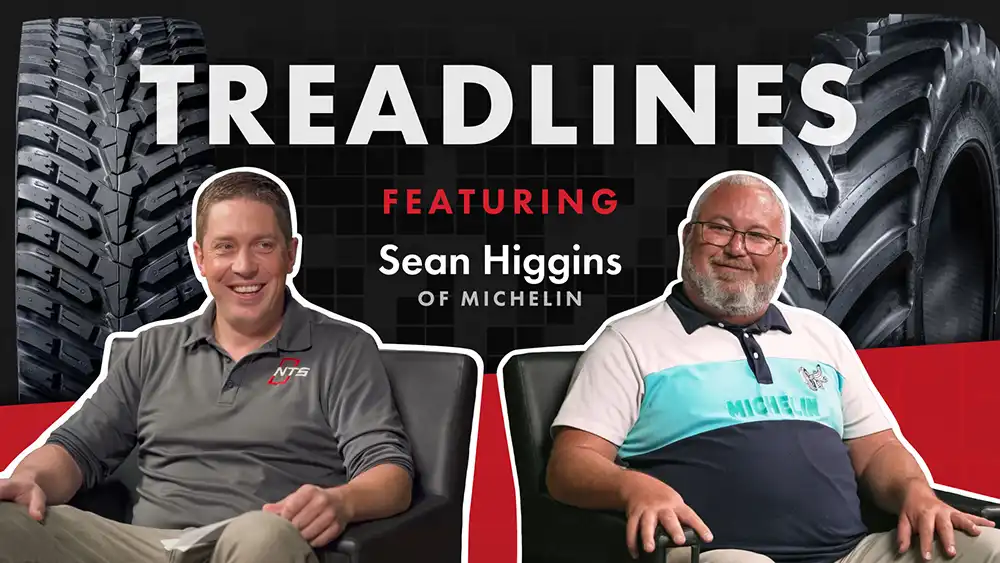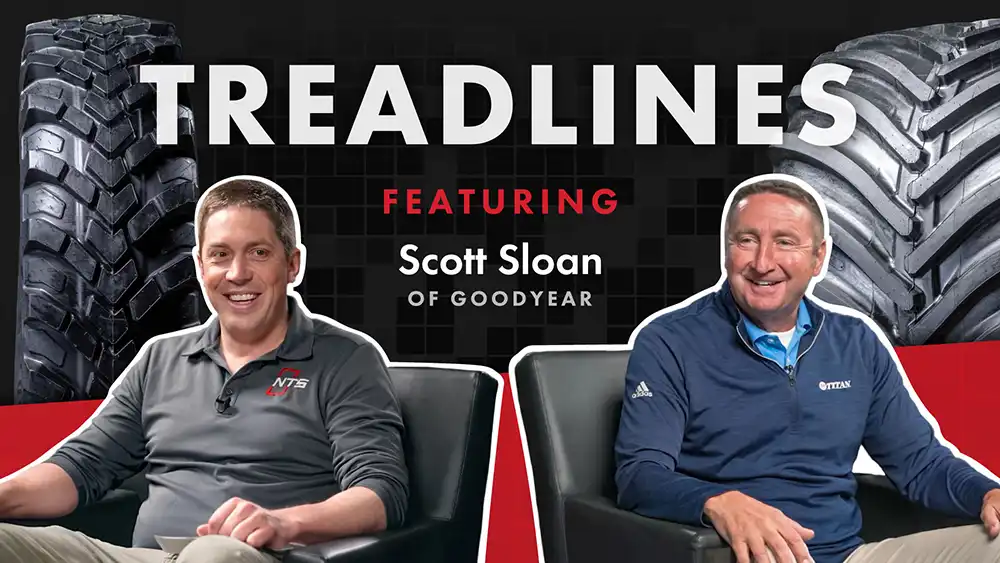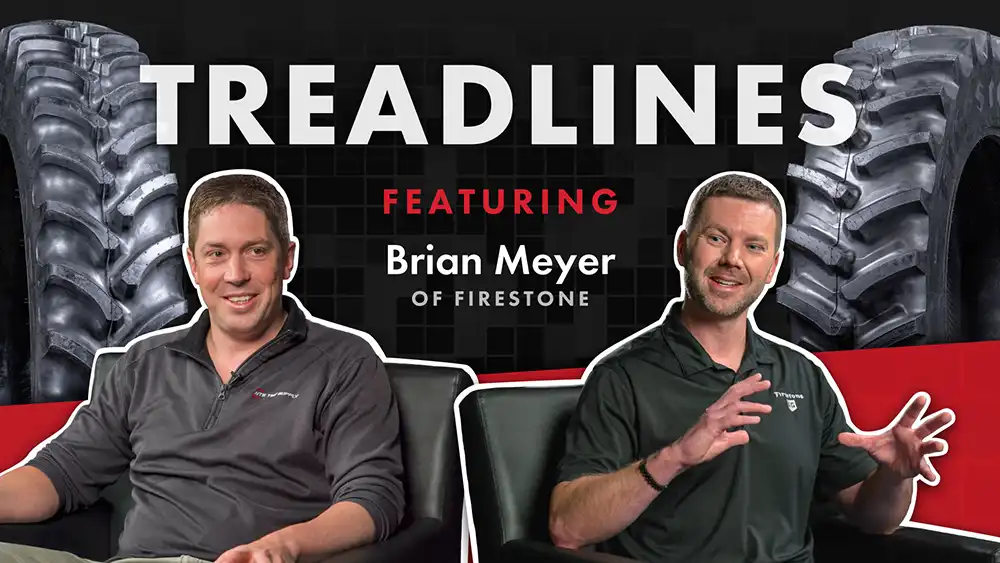The right tires set to the right air pressure will add dollars to your bottom line. This is how David Graden, Global Account Executive with Michelin, summarized the company’s 2023 Ag Road Show. Held at Crystal Creek Enterprises in Grand Mound, Iowa, the show demonstrated what we’ve been saying all along: Tire footprint is one key to boosting your farm’s bottom line.

Digging In: More Footprint will Save You Money and Time
To illustrate the importance of footprint to a farm’s productivity (and bottom line), Michelin staff created a 230-yard-long testing area in a harvested oat field. The ground was firm, with little moisture received over the summer months, and the field had not been worked. During the first half of the Road Show, the company ran two tests over this ground to demonstrate how important tire footprint is to traction.
If you’ve read our PTK blog before, you know that any time you can decrease wheel slip and boost traction you’ll improve your fuel economy and spend less hours working in the field. But exactly how big a difference can the right tires and air pressure make? That was what Michelin’s Ag Road Show was designed to demonstrate. We were there to witness the tests, and here’s what the demonstrations showed:
Test 1: Michelin VF Tires vs. Michelin Standard Radials
The first test of the day pitted two (nearly) identical John Deere 8R 410s against each other. For this test, Michelin had the two 8Rs connected via a cable-and-pulley system to a 9R braking tractor, which was pulling an 8-shank subsoil ripper.

The two 8Rs were operating at 1800 rpm, with a target ground speed of 2.7 mph. The 9R braking tractor was set to run between 2 and 2.5 mph. The cable-and-pulley system was designed so that if one tractor and its tire setup could outpull the other, the tractor would be able to surge ahead on the testing ground. And that’s exactly what happened.
Test 1: Lower PSI Results in Higher Efficiency
Notice the main difference between the two tractors in test one: air pressure. Tractor one ran with 95-series tires, with taller sidewalls than the 80-series tires on tractor two. When you compare the two rear tire setups, the Yieldbibs have air chambers that are approximately 20% larger than the Agribib 2s, even though the tires are the same width. The larger air volume and VF tire technology allows the Yieldbib to carry more weight at any given air pressure than the Agribib 2. As you’ll notice in our homespun illustration, the Yieldbibs’ tire pressures were half of what Michelin was running on the tractor with the Agribib 2 tires.
As attendees watched the test unfold, they could clearly see tractor one (with the VF tires) pull ahead of tractor two, which was wearing the standard radials. Tractor one’s tires had much more sidewall flex, which translated to more lugs on the ground for more pulling power. And what did this translate to in terms of higher efficiency?



Based on test one’s data, it would cost you $273.70 in lost productivity (fuel, labor, and work done) to stick with standard radials. Or, you could say that upgrading to the taller, VF-rated radials would add $273.70 to your bottom line for every 1,000 acres you worked.
Now, it’s not important to sear these exact numbers into your mind. After all, these numbers could vary wildly depending on your tractor, what you’re doing with it, the soil type, etc. We’ve published Michelin’s numbers here in their entirety so you can get a full picture of the performance differences for this particular test protocol.
If we could point you to one number that stands out the most to us, it’s the wheel slip results. Look again at how the VF Tires slashed wheel slip by a third or more. Even if you throw out all the other numbers, the wheel slip alone demonstrates that, yes, footprint is king when it comes to maximizing your time in the field. And if you’re slipping, your profits are slipping, too!
Test 2: VF Yieldbibs vs. Goodyear LSWs
For test number two, the Michelin folks pitted tractor number one (from test one), outfitted with VF Yieldbib tires, against tractor three—another 8R410 that was outfitted with Goodyear Optitrac LSW super singles. Michelin staff described test two as a comparison between really wide footprints and really long footprints.

Once again, the two 8Rs were operating at 1800 rpm, with a goal ground speed of 2.7 mph. The 9R braking tractor, pulling the subsoiler, was set to run slower than in test one. Air pressure differences between the two test tractors weren’t as big as in test one. The big difference in this test was the design philosophy between the two tire brands: Michelin with its tall, ultra-flexible sidewalls and Goodyear with its shorter, stiffer LSW design.
Test 2: Michelin VFs Leave LSWs in the Dust
From the sidelines, test two showed an even greater difference between the two tractors when compared to test one. Michelin’s safety director had to prompt the crowd to “step back!” as tractor 3, equipped with the Goodyear LSWs, struggled to steer in a straight line down the test field. Several times it nearly drove through the boundary and into the crowd as its driver struggled to keep control of the tractor. (You’ll understand why when you see the wheel slip readings below.)
As attendees carefully watched the test unfold, the difference in the performance between the two tractors was obvious and, if you have a flair for the dramatic, just a little bit shocking.



Why did the wheel slip numbers jump so dramatically in test two? The Michelin team tinkered with the speed and setup of the 9R anchor tractor a bit to make the two 8Rs work harder than in test one.
Based on test two’s data, it would cost you $541 in lost productivity (fuel, labor, and work done) when rolling with the 8R’s LSW setup. Or, you could say that rolling with the Michelin Yieldbibs would add $541 to your bottom line for every 1,000 acres you worked.
As with test one, it doesn’t pay to obsess over the specific “efficiency” numbers with test two. But look again at the wheel slip on its own. Traction matters if you want to increase your farm’s efficiency. A larger footprint will cut your slip percentage and save you valuable money and time.
Another Word About Tire Brands
Let’s step away from Michelin’s Ag Road Show data for a paragraph (or two) to talk about tire brands. At NTS Tire Supply, we serve farmers as unbiased traction experts. Maybe you’ve noticed, but we don’t plaster tire companies’ logos all over our website or go out of our way to cheerlead for one particular brand or another. As we’ve sold tires over the years, we have built up our own list of favorite tires for every application. And our favorite tires happen to come from a wide spectrum of brands across the industry.
So, are we going out of our way to toot Michelin’s horn here? No—that’s not our intent. We’re just reporting on what we saw during the Road Show’s two comparison tests for three reasons:
- Michelin was kind enough to invite us.
- Michelin was kind enough to feed us donuts, lunch, and ice cream (slightly joking here).
- Michelin’s tests confirmed something we’ve told farmers over and over for years: You have to run the right tires at the right (low) air pressures in the field to maximize your farm’s productivity.
As you’ve just read, the LSW tractor turned in an embarrassing performance during test two. Does this mean that Goodyear LSWs are horrible tires? In our experience, we’ve never preferred them for heavy-duty pulling. This test seemed to confirm that advice. But, Goodyear LSWs have served our customers well (among other options) for several applications, including on combines and even planting tractors.
The “right” brand and model of tire depends on your specific needs and your budget. In some situations, we’ll definitely recommend a premium tire, such as the Yieldbib; in other instances, a used tire or middle-tier tire will fit the bill. That said, Michelin makes excellent tires; they often occupy top spots on our favorite tire lists for everything from high-horse tractors to sprayers.
Increase Your Footprint to Inflate Your Bottom Line
Yes, efficiency in the field comes down to air pressure. To optimize your tractor’s traction (and even flotation to minimize soil compaction), you want to run the lowest air pressures as possible in the field. Our farm tire experts are eager to help you choose tires for your high-horse MFWD or 4WD pulling machine. You may even want to invest in a central tire inflation system, especially if the tractor in question pulls a planter or sprayer. Share some details about your land, your goals, and your budget with our experts, and we can steer you in the right direction, whether that’s a set of Michelins or another brand. With tires that maximize your traction beneath your tractor(s), you’ll Drive Your Farm Forward.

.png)
.jpg)



















